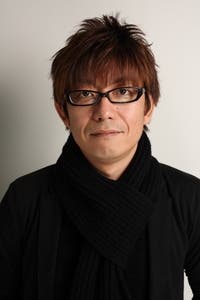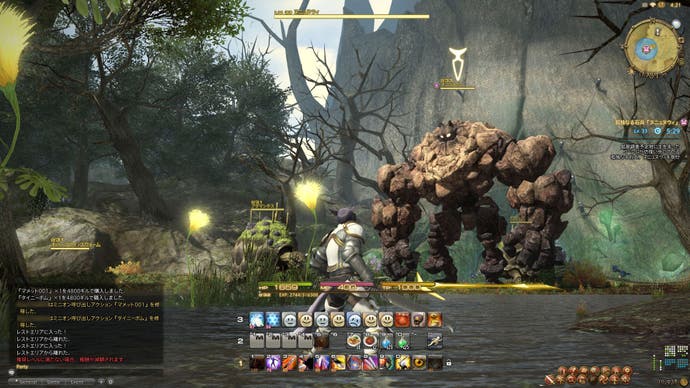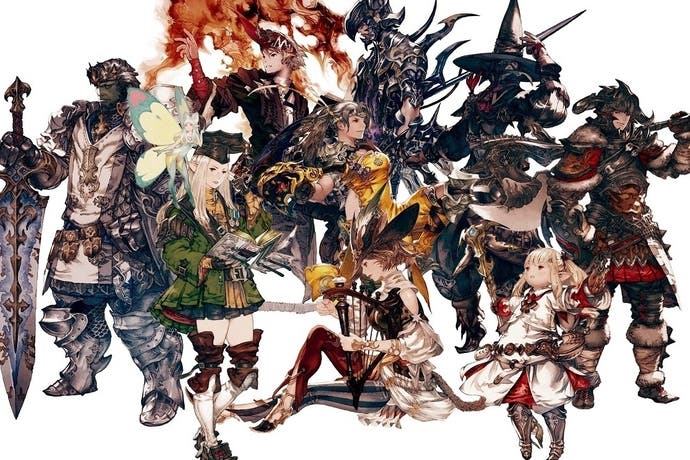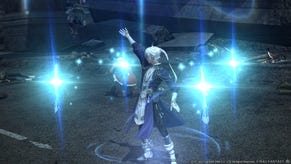Meet the man who salvaged Final Fantasy 14 from ruin
Naoki Yoshida, world saviour.
On 27th August 2013 Naoki Yoshida, over-worked, overtired and twitching on caffeine, paced backstage at a press conference in Shibuya, Tokyo. In a few minutes he was due to proclaim the arrival of Final Fantasy 14: A Realm Reborn to the world in a live broadcast. It should have been a happy moment, yet Yoshida felt nothing but nausea.
Big budget video game development can be a traumatic experience. A blockbuster game's gestation is, after the initial thrill and excitement of conception, long, gruelling and problematic. The final push of delivery is painful; the team is up all night (the word for these prolonged hours, "crunch", bespeaks unbearable pressure) and, when the game finally emerges into the world, spent.
Yoshida's experience was especially traumatic. Final Fantasy 14's original launch in 2010 had been a multi-million dollar flop, a massively multiplayer online RPG that launched prematurely and in a broken state. The president of Square Enix, the game's publisher, said it had "greatly damaged" the Final Fantasy brand. For three years Yoshida's job had been to work to undo this damage, to ready the realm for a rebirth. He had carried the weight of a world on his shoulders.
For three days prior to the Shibuya event, thousands of players around the world had been granted early access to the game. They had logged on in droves, so much so that they caused the game's servers to clog and stutter. Many players had been unable to create a character and now, a few hours after the game had opened its gates to the world, almost nobody was able to squeeze online. Yoshida had grossly underestimated the number of players the game would attract; his grand plan to save the realm of Final Fantasy 14 appeared to be in tatters.

On stage, Yoshida bowed his head and apologised. "I am really sorry," he said. "Our long journey is just beginning and I hope..." Then he broke off and broke down, bringing a hand to his face while the heads of the game's development team stood in awkward, stoical silence behind him. After a few moments someone in the assembled crowd called out: "Ganbare!" - "You can do it!" Another voice took up the cry and then another until there was a chorus of people cheering Yoshida on, each swell of noise adding to his grief. He regained his composure and continued: "I wasn't going to cry... Today marks our first step. This is only the first step."
Eight months later and Yoshida and his game have none of the faltering insecurity of those first few days. As he takes to the stage at the Game Developer Conference in meticulously ripped jeans and dyed hair he is greeted like a hero. After his presentation he is surrounded by audience members, many of whom work on MMOs themselves, who want to shake his hand or have a t-shirt or an arm signed. The game has become a wild success, restoring players' faith in Square Enix and, for many, in the broader series. It has also demonstrated that, despite World of Warcraft's declining population, there is still an appetite for these vast virtual kingdoms, in which players pay a monthly subscription tax to live.
Yoshida's success has established him as one of Square Enix's most promising directors, just as many of the publisher's other Japanese titles appear beset with problems of both identity and execution. Nevertheless, he tells me that he would prefer to forget his vulnerability at the Shibuya press conference. "It was pretty embarrassing tearing up like that at the launch event so I would rather forget it if you don't mind..." he says, with a nervous laugh. "But I really was relieved when we finally made launch. It was a lot of pressure. So when I heard those shouts of support and encouragement from the audience I was moved."
The failure to supply a sufficient number of servers for the game's launch stemmed from Yoshida's belief that trust in Final Fantasy 14 had been irrevocably eroded. "That's how I felt so I assumed most other players would be too," he says with rare honesty. "I thought that perhaps people would only give the game a try after hearing something from a friend. But these conservative expectations were turned on their head with the response to the third phase of beta testing. Players flooded in. It was completely unexpected. Ultimately it confirmed my conviction that what is most important for a developer to bear in mind is making sure that the game itself is interesting and appealing."
Yoshida, whose career began at Hudsonsoft where he worked on Bomberman, is an avid MMO player. When he was brought in to fix the original Final Fantasy 14 (a game from which he constantly distances himself: "I was not involved with the original FF14 at all") he perceived what others had not: the game's problems stemmed from deeper issues at Square Enix. During his GDC presentation Yoshida explained that, during Sony's PlayStation era, the company had become "obsessed with visuals". It was a focus that had, he said, harmed its output. As an example of where the development effort had been mistakenly applied, he points out that, in the original Final Fantasy 14, a single flowerpot contained around 1,000 polygons and 150 lines of shader code, "the same amount as the entire player character model."
When Yoshida joined the team he made drastic and immediate changes. He wrote a list of more than 400 core design changes which he believed would bring the disparate parts of the game together and draw them into a coherent, aligned whole. He then allocated each of these areas to a trusted designer to implement and, in this way, began to rearrange the faulty game into something that worked. Each senior designer had their own team, and Yoshida encouraged competition between the various teams, who then presented their work to one another. Where management had previously been reticent to openly discuss problems with the game with staff, Yoshida cultivated an environment where both dreams and disillusionment could be freely spoken about. "It was so much healthier," he says.

For Yoshida, listening to feedback from both designers and players has been key. Where many of Square-Enix's other high profile directors have, in recent times, forged their own creative path with long-running series, often to the dismay of fans, Yoshida became obsessed with what players wanted. He visited the game's online forums every day and ordered one staff member to prepare a weekly report that listed each player request on the forums and allocated it a priority rating for implementation. "Regardless of what game designers say, it is always great to receive feedback on your games," he tells me. "Of course I appreciate people who just say how much fun the game is but I feel the same about criticisms too. If we stop getting feedback it pretty much means that people have stopped playing the game, so good or bad, I am always glad to hear a response."
While infuriated players complained about the insufficient number of servers during A Realm Reborn's first week of release, Square-Enix was quick to respond and, in turn, the cries of anger soon changed to praise. "I believe that the deciding factor in whether a title is successful or not always comes down to how interesting the game itself is," he says. "When we looked at the play data for the third phase of beta test it was amazing how much time players had put in to the game, even though they knew that their character would all be wiped at the end of the tests. That gave us the first indication that the game might catch on. Being shown that what you have made is exciting and entertaining is a great boost."
Yoshida is no detached creator. He likens running an MMORPG to running a country. "If the development team is the government, then players are the citizens," he says. "If citizens disapprove of your policies then they will emigrate." For Yoshida, it's crucial that the designers are committed to the game in the role of citizens, as well as governors. "If the leaders of an online world don't live there, then why would their subjects?" he says.
While Yoshida's role in A Realm Reborn's success is indisputable, he would have been unable to deliver on his vision without the publisher's unwavering financial support. "Our efforts were backed up by the whole Square Enix group so nothing was impossible in terms of our ideas," he says. It's clear that the publisher was willing to invest as much money as was required in order to undo the damage the Final Fantasy brand had, according to the CEO, sustained. In the same month that A Realm Reborn released, the company reported financial losses of 1.6 billion yen. While Square Enix is yet to report whether the game has recouped its development costs, the company's financial report for the nine-month period ending December 31, 2013 declared a profit of 5.2 billion yen. The report stated that Final Fantasy 14's subscriptions and sales showed "favourable progress."
With the PlayStation 4 version of the game, launched this week, Yoshida and his team hope to build upon that progress. "The PlayStation 4 is a very easy platform for us to develop for and we are very happy with the hardware," he says. "It really is in the top class of what I have seen in my career as a developer. Development was so smooth we reached the mastering stage for A Realm Reborn in about four months. There were no major issues at all in the development process."

There have, however, been issues with keeping ahead of the game's most determined players. Yoshida likens the running of an MMORPG to the running of a country, but it's also a lot like laying the track ahead of a fast-approaching train. A small group of players always race to be the quickest through a new MMORPG, to reach the 'level cap', the point at which experience points no longer count towards raising their character's stats. They are fuelled by the desire to be first, to play the meta-quest and triumph not just against the game world, but also against other players. "We designed the game so players would have to complete the main storyline before they could reach the level cap," says Yoshida. "We estimated it would take a player at least 57 hours, and only if they ignored all side-quests and neglected to read any of the game's text. When we looked at the play logs we saw that the first player to reach the cap managed it in slightly less than 57 hours, so we were close. This is an exceptional case though; it's not a useful guide for most people."
In order to create new content for this rare class of insatiable player, Yoshida and his team have worked hard to release a steady stream of content updates, expanding the world, its fiction and, of course, providing new adventures for those who have exhausted those on offer. "Building in more kinds of non-completion focussed, open ended content for players who wish to play the game for very long periods is the most important thing for a successful MMO," he says. The team is concentrated on crafting 'endgame content' like the Binding Coil of Bahamut, the Crystal Tower and an extensive player versus player arena known as Frontline.
There has been time in amongst all the hard work to marvel at the way in which some players have confounded the team's expectations. "We have been surprised at the dedication and ingenuity that players have applied to tackling the game's challenges," says Yoshida. "In particular we were blown away by the ingenious and completely unexpected tactics and strategies that players used on the super-high difficulty endgame content. A Realm Reborn is designed to accommodate the kind of casual play that fits in with modern lifestyles, but we have received a lot of feedback from players saying that they want to put more time into the game or play for longer and more involved sessions, so we have moved some of our plans forward and want to respond to those demands as soon as possible. I can't let up on my efforts now."









